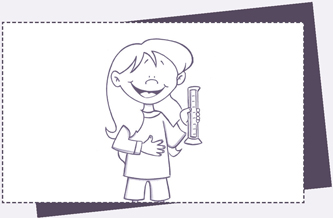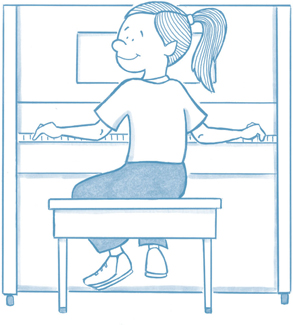Everything Kids' Magical Science Experiments Book (13 page)
Read Everything Kids' Magical Science Experiments Book Online
Authors: Tim Robinson
Tags: #epub, ebook


At this site, you can see optical illusions organized by type. Learn more about how eyes can be fooled at:
www.colorcube.com /illusions/illusion.htm.
Question: Can your breath clean water?
In this experiment you will take a bottle of water that has been colored red and, simply by talking into it, change the coloring of the water. You will first have to use the proper form of coloring, as only certain liquids will react to your voice in this way. Then, it simply takes patience, and having a lot to say, before you can see the results of this amazing process.
Phenol red is a special form of dye often found in pool supply stores or drugstores. When added to the water in a pool, it changes color based on the acidity of the water. The change that occurs in the test water tells the tester whether the pool is safe for swimming, or whether additional chemicals should be added before anyone enters. This experiment reverses the process. The phenol red turns the water a light red color. By talking into the bottle, you are breathing out carbon dioxide, which reacts with the water to produce a weak acid. Slowly, as more carbon dioxide is breathed out, the acid that forms changes the red color in the water. In time, the red color will be a different color.
KIDS' LAB LESSONS


SAFETY NOTE:
It is not safe to drink water that has been mixed with chemicals, no matter how clean it appears. Be sure to discard any water you use in a science experiment, and to only drink water that you know to be clean and safe.
- 1 small bottle of phenol red
- Baking soda
- Empty 500-mL (about 16-ounces) wide-mouth bottle with screw-on cap
- Tap water
- Fill the bottle with approximately 250 mL (8 ounces) of tap water.
- Add three drops of phenol red to the water, screw on the cap, and swirl the bottle to mix the color.
- If you don't see the water change color noticeably, try adding small amounts of baking soda and swirling. Baking soda should bring out the red color in the water.
- Unscrew the cap and speak into the bottle. You might try saying one sentence at a time.
- Replace the lid and swirl the bottle.
- Repeat steps 4 and 5 until you begin to see the color in the bottle change.
- If you wish to repeat this experiment, simply add more baking soda to the water mixture until the water turns a red color again.
- How long did it take until the red color began to change in the bottle?

- Do you think that the same sort of reaction would happen if you left the water out in the open for a period of time? Why or why not?

- What sorts of materials could you add to a phenol-red water solution that might produce the same effects as those you found in this experiment? You might want to ask a parent for help with this question.

- Do you think it would be possible to use people's breath to clean a swimming pool? Why or why not?


More than two thousand years ago, one of the greatest mathematicians of all time, Pythagoras, discovered a connection between math and music that young musicians have been putting to use ever since. He figured out that two musical notes played on strings with the correct lengths produced notes that sounded nice together. Others sounded really bad. Now you get to explore this amazing relationship.
Question: Which musical notes
sound good together?
You will be using a list of frequencies and a piano to produce pairs of tones. You will then ask several of your friends or family members to tell you which pairs sound good together, and which ones produce sounds that don't go together. After you survey your test subjects, you will then put together a prediction as to the pairings that produce the most pleasant sounds.
Pythagoras discovered that certain frequencies of musical notes seemed to match better with others. In his day, he could produce these notes by plucking strings of different lengths. Today, we have pianos that can produce the different notes. When two notes with frequencies in specific ratios, such as 2:1, 3:2, 4:3, etc., are played together, the resulting sound is generally a pleasant one to hear. However, other ratios often produce sounds that do not sound good together. This is due to the patterns of the sound waves and how they interfere with one another. When the patterns interfere in a regular pattern, the notes sound nice together. When they do not interfere in this manner, they do not sound nice together.
- Piano or similar keyboard
- Chart of musical frequencies
- Test subjects
- Use the included list of pairs and play each pair in order for your test subject.
C-D D-F E-B C-E D-G F-G C-F D-A F-A C-G D-B F-B C-A E-F G-A C-B E-G G-B D-E E-A A-B - For each pair, have your test subject decide whether or not the combination makes a pleasant sound or an unpleasant one.
- Repeat steps 1 and 2 for each of your test subjects.
- Use your data to compile a list of those note pairs that your subjects enjoyed hearing and those pairings that they did not enjoy.
- Compare the frequency ratios of the pairs your subjects chose to those listed to determine if they found the same ratios as Pythagoras did.

To learn more about sound, music, and harmony, visit this ThinkQuest site called The Soundry:
http://library.thinkquest.org/19537.
